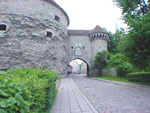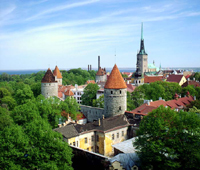First, a couple of misconceptions. Estonia is not, as my doctor
believed, in Turkey, but is a small independent country to the far north of the
Baltics. The Baltics being a group of three former Soviet states in the north of
Europe, and not the scene of recent troubles involving the Serbs and
Kosovars. To the north of Estonia lies Finland, to the west Sweden, to the
south Latvia, and to the east Russia. The close proximity of these countries
has indelibly left its mark on Estonia as a nation. In fact, Estonia has only
been an independent country for two short periods in its history, between the
First and Second World Wars and since 1992. This being so, it is a testament
to the strength of character and resourcefulness of Estonians that it has
survived as a country at all.
My experience and love of Estonia came from being an English
Language teacher based in Tallinn, the capital, in 1999/2000. My first view of
Tallinn came from the air, and a more depressing place I had not seen. It was
like something out of Ghorky Park - Stalinesque concrete blocks and
grey grass. However, I could not have been more wrong. I admit that the
outskirts of the city are like any other former Soviet city, but Vanalinn (the Old
Town) is the most beautiful place I have yet seen - medieval towers, turrets
and walls, Orthodox cathedrals, and picture-postcard cobbled streets. Real
chocolate box stuff. Thankfully, my school was situated in Vanalinn, in a
converted 14th Century merchantís house.
A walk around the streets of the Old Town will reveal something of the
history of Estonia. Amongst others, the rotund tower Paks Margareeta (Fat
Margaret), to the north, demonstrates Tallinnís strategic importance and
desirability, as does Pikk Hermann (Tall Herman) which still has 16th Century
cannon balls embedded in the walls. Vene Tšnav (Russian street) and the
Alexandr Nevsky Cathedral show Estoniaís considerable Russian influence,
in fact the spire of Oleviste church (St. Olavís) was used as a communications
antennae during the Soviet occupation. Raekoja Plats (Town Hall Square)
and the Raeapteek (Town Chemistís) within the square reveal Estoniaís
Germanic past.

The Estonian language also gives us clues to Estoniaís multicultural
(or should that be multi-oppressed?) history. Although not part of the
Indo-European language family (it is Finno-Ugric, like Finnish and
Hungarian), Estonian has, like English, many borrowed words, mainly
German. Visitors may find the language strange (more like Latin with
inflections and declinations - what are commonly called Cases), but speaking
a few words helps to break down barriers, although my experience is that it is
very difficult to practise Estonian with Estonians, as they would like to
practise their English - cue interesting bi-lingual conversations. Useful words,
however, are Tere (hello), Nšgemist (seeya), Palun (please), and Tšnan
(thanks). Pronunciation is very simple, with only one exception. All the letters
are pronounced like English, but you must pronounce every letter. So Tere is
teh-reh, Nšgemist is na-ge-mis-t, etc. The only letter which doesnít have a
sound in English is ű, which sounds like ur, but with a smile. This is an
important letter/sound as the word for beer is ’lu.
As you might expect, alcohol is a passion in Estonia, where the
particular delicacies are Viin (vodka) and Vana Tallinn (Old Tallinn - a sweet,
dark liqueur). The locals donít generally drink Vana Tallinn, it is regarded as a
touristsí drink, I quite liked it (I suppose I was a tourist), but vodka is the drink of Kings.
However, contrary to what you might expect, as I did, bitter is on sale in most
bars in Tallinn, I expected lager but "Bishopís Finger"?. This quickly made me
feel at home, although the licensing laws didnít (they donít exist). Think
Europe. Donít go to bars before 10pm and night-clubs before 2am. The other
surprising thing about Estonian bars is that they are all run by Scots. You
order a drink in your best Estonian and the answer comes in broad
Glaswegian "Thatíll be 25 croons, please". The story goes that they arrived
for the Estonia-Scotland football match that never was, and didnít go home
(Do yer ken?).

The Scots add colour to life in Tallinn, not that it needs much adding, as the
Estonians are a party race. Not quite in the same way as the Brits (they donít
invade a country, and then decorate it with verbal and physical waste), they
are an altogether quieter nation, very Scandinavian, but need no excuse for a
drink and a sing-song. In fact, the independence movement that started in
1988 gained power in 1992 through the Singing Revolution. Many of the
folk-singing figures went on to become the leaders of the new independent
Estonia. The culture has an overload of patriotic songs and festivals, and for
many these are the only reasons they survived so many years in the
wilderness. I finished many parties in the woods singing mighty Estonian folk
songs (or not singing, because I didnít know the words, and my Estonian
wasnít good enough, although I could do a good "Ilklaí Moor Bahítíat", which
in itself is a national anthem).
Foreign tourists to Estonia will find it to be a west-ward looking nation,
keen to join with its European neighbours, and build a new strong
independent future. It is also one of the most beautiful places on Earth.
†
www.tallinn.ee/english/index.html - Official Tallinn Homepage
www.scottishfa.co.uk/fixtures/wc98/estonia1.htm - Estonia vs Scotland (The game that Estonia forgot to turn up for)
www.tourism.ee/ - Estonian Tourism
www.geocities.com/torpster2000/eesti.html#phrase - (Interesting) Estonian Phrasebook